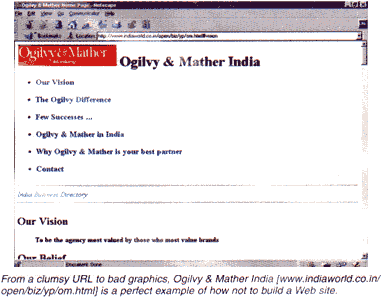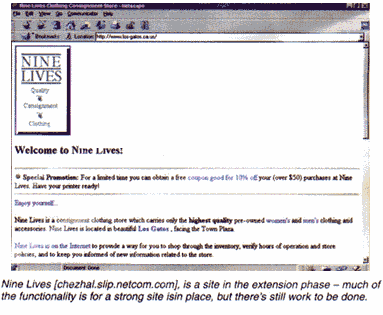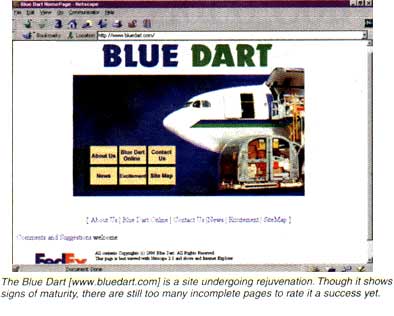 |
The Website Life Cycle |
The Internet is a tough realm in which to get established. It's a unique fusion of traditional media; newspaper, billboard, magazine, radio, telephone, and video, all bundled with an increasingly sophisticated range of technologies.
As companies around the world are struggling to build a coherent and practical Internet presence, experimenting and learning as they go, the website goes through a life cycle of its own.
Saying that a website has a life cycle implies that a website has a limited life, and goes through distinct stages through this life. Traffic to the website varies with these stages, increasing and decreasing depending
on the current stage in the site's life. In each stage, the website needs nurturing to take it forward, failing which the life cycle terminates in an early death.

The life cycle of a website could
be portrayed as shown above. This pattern is typically divided
into five stages : launch, realisation, rejuvenation, extension,
and consolidation. The graph shows how traffic to the website
(on the vertical axis) changes with the current stage in the life
cycle of the website.
Launch
There are few businesses who have not at least considered building a web presence. Not being familiar with this new medium, many companies
test the water by putting up a homepage at the least
possible cost. The creation is often left to a local college student, or the DTP department, which gets hold of the first "build-your-own-website" software package it sees. The result is often known as "brochureware" - a page or two on the Web that has a company logo, followed by paragraph after paragraph of text, and big pictures of the management team. Not to forget the counter that will proudly
show how popular the page is (unless it's broken). The page ends with the customary contact address, phone and fax numbers, and if the company is savvy enough, an email address.
The problem here lies in the fact that the entire exercise has been carried out unprofessionally, resulting in static web pages that are nothing but online versions of pamphlets; a big turn off for any visitor. Besides, one of the objectives of going online - to be seen as fresh and technologically in-touch - is defeated.
 An example of a typical one-page cover letter site would be the homepage of Ogilvy & Mather India (http://www.indiaworld.co.in/open/biz/yp/om.html). This is one long text-intensive page that has not been changed since it was created over two years ago. |
Realisation
Soon the company realises that most of the time, the counter increases
only when staff proudly visit the site to see how well
it's doing - not too many people from outside the company seem
to be visiting the page. Lesson number one strikes home
: the adage, "build it and they will come", doesn't
hold true here - but "finding a needle in a haystack"
seems to describe the situation better.
Publicising the home page now becomes a priority, with a Net-savvy employee registering the site with search engines (like AltaVista) and directories (like Yahoo!). Then come announcements in newsgroups and online bulletin boards and classifieds listings. Emails sent from the company now have a default signature file, with the URL (Uniform Resource Locator - the homepage address) prominently highlighted with other contact information. Offline publicity follows too, usually by word of mouth and small press releases.
The fruits of these efforts are seen in a slight surge of traffic to the homepage for a few weeks as curiosity overtakes people who come across the URL. But before the smiles can be etched on the faces of those related to the development of the homepage, the traffic starts decreasing, sliding down towards the original negligible levels. Time for lesson two : "There's nothing to draw people back time and again - no repeat value". With a little more effort, lesson three becomes apparent : "The homepage address is not intuitive". If someone's looking for the CNN homepage, just typing in http://www.cnn.com will get him there. How is the average surfer to find your homepage if it has an address on the lines of : http://www.someone-elses-server.com/someothername/yourcompanyname/index.htm ?
This is a very important stage - the fingers that control the purse strings either write this entire exercise off as a bad investment and drop it, or realise the potential and decide to go all out to establish an effective online presence. The former results in stagnation and gradual death due to neglect, while the latter leads to the next stage - rejuvenation.
Rejuvenation
This is the turning point for the
company's website. The company either forms a team to exclusively
look after the site - development, improvement and constant maintenance,
or decides to leave the site in the hands of a professional Internet Presence Provider.
More often, going in for the second option leads to better results,
since the website is safely left to specialists. Rejuvenation almost always involves drastically changing the homepage, in the following phases :
- Conceptualisation: Factors such as target audience, the how's & why's of the website, corporate image to be portrayed, and the potential of the site are taken into consideration. Good Presence Providers get their hands on all possible information about the company, study it inside out, and then start this phase. It's important to stay tuned to the Internet user's personal FM frequency - WII-FM (What's In It For Me ?) - and include useful sections for the target audience - be it recipes on a food-related site, or an email reminder service on a greeting cards site.
- Website Design, Development and Hosting: The concept is converted into reality - the site is broken down into sections, and further into individual pages. The pages are then created one by one, maintaining consistency and continuity. Developing an aesthetic yet simple design is crucial. Hosting decisions involve either hosting the website on the company's own server, or renting space on a server for the website. Today, a domain name is a necessity in projecting a professional online image
- Marketing a Website: It's no use having a gem if you keep it hidden. The traffic to a site depends on how well the site is marketed, both online and off. Banner advertisements, search engine and directory listings, reciprocal links to related sites are just as important as making the URL an integral part of any real-world communication of the company, such as stationery, business cards, and press releases.
- Website Administration: Countless companies trip up by not maintaining their site and kepping information and links current. This usually is a never-ending phase. Feedback from visitors needs to be monitored and acted upon. After analysing the website access logs, popular sections are maintained and the other sections are spruced up to increase the interest levels of the site.
Extension
The rejuvenation stage leads
to an increase in the traffic to the site, of both - new visitors
and repeat visitors. After the initial euphoria wears off, the powers-that-be begin to understand
what the Net is all about and the potential it has, leading to
a renewed commitment towards the website.
The Internet is no longer
looked upon as a giant billboard that millions have access to,
but instead as an integral business tool that enables advertising, sales promotion, direct marketing, information
dissemination, customer support and even recruitment. User involvement is introduced and
new features are added to the site - the balance sheet, a newsletter,
user manuals and guides, a searchable database of the nearest
point of purchase, or maybe even a product catalogue. The site
can even be used to customise content for individual customers
by keeping track of his preferences - the mass-customisation dream !
This stage highlights the savings of the company because of
the website - small things like savings in printing and postage
charges because the information is online. However, the website
is still in the window shopping stage, where the customer can
see products and services, but cannot buy them online.
 A great example of a website in the extension stage, the Nine Lives website(http://chezhal.slip.netcom.com) allows customers to search the inventory, verify hours of operation and store policies, and to stay informed of new information related to the store. Nine Lives' Personal Assistant provides individual attention to customers as desired. Participating customers receive email when new items matching their profiles arrive. Besides strengthening customer relationships, this service supplies Nine Lives with accurate customer data that enables the company to market more effectively. However, there's no buying / selling online for this California-based consignment store. |
Consolidation
This is currently the ultimate stage
a website can achieve. The Internet is exploited to its
fullest potential, by tying up all possible activities with the
website. Sales transactions can be completed online, right from
finding out detailed information about a product, to order and
payment and in some cases, even shipping (as with software products).
That's E-Commerce for you. Naturally, security systems need to
be in place first. Add to that an extranet, and vendors, suppliers
and partners can also be linked up to carry out their business
online. Tying in an intranet would allow the entire company and
all its departments to be connected to the Internet, while still
maintaining privacy and security within the organisation. Intranets
and extranets will reduce the cost of doing business, and will
benefit the final customer through lower prices and better service.
Death in the life cycle can be prevented if the company stays abreast of the innovations in the world of the Internet and adapts with those changes. And with the Web at your command, you are no longer restricted by where you are, who you are, or how big you are. On the Web, what matters is what you have to offer, and how well you offer it.
| Look up the virtual bookstore Amazon.com (http://www.amazon.com) for an example of a website in the consolidation stage. Books can be ordered, paid for, and delivery status checked online. Heavy discounts and contests are constantly offered to entice surfers to purchase online. A search engine allows you to easily find a book you're interested in. And when you do find a particular book, it shows you the other books people who picked up the title also bought. Readers can add their reviews and rate books they have read for interactivity. When a surfer makes a purchase online, he's added to a mailing list that informs him of new offers. |
While the website life cycle holds true for most websites, there are some exceptions - not all websites go through the five-stage life cycle. Some websites precariously lie between stages - neither here nor there.
 The Blue Dart website (http://www.bluedart.com) has not gone through the rejuvenation stage thoroughly. Though it has its own easy-to-guess domain name, a lot of useful information and a well thought out structure, it is lackluster and even incomplete in sections - a no-no for any respectable website. |
The more visionary companies start the life cycle directly from stage three. This is either because they've understood the Net, or learnt from other's mistakes. Deciding to launch a website directly in the third stage involves commitment from the management and a bigger budget, but these costs easily override the time and effort that are wasted into the first two stages.
A corporate website is a virtual representation of the company on the Internet - projecting a particular image of the company to the entire planet. That's why staying in the consolidation stage is very crucial. Companies that learn to treat this website as a branch, and invest as much effort into developing and maintaining it, as they would a real branch office, will succeed in making this venture a profitable one.
Neglecting it would mean eventually closing the most accessible
branch the company could ever have.